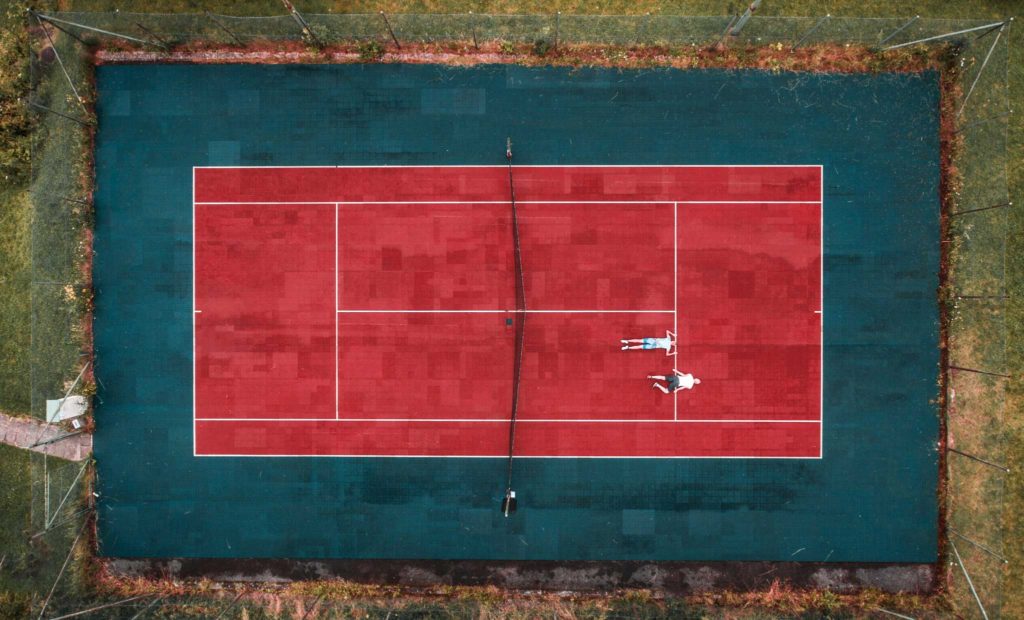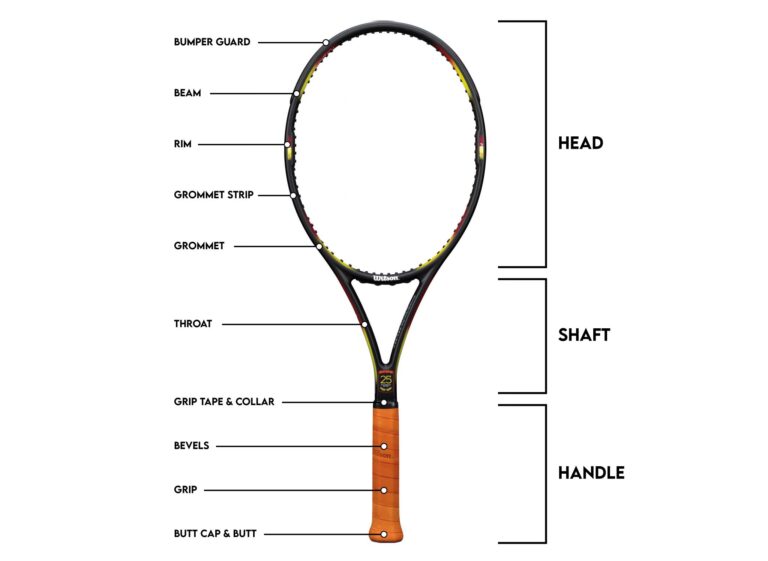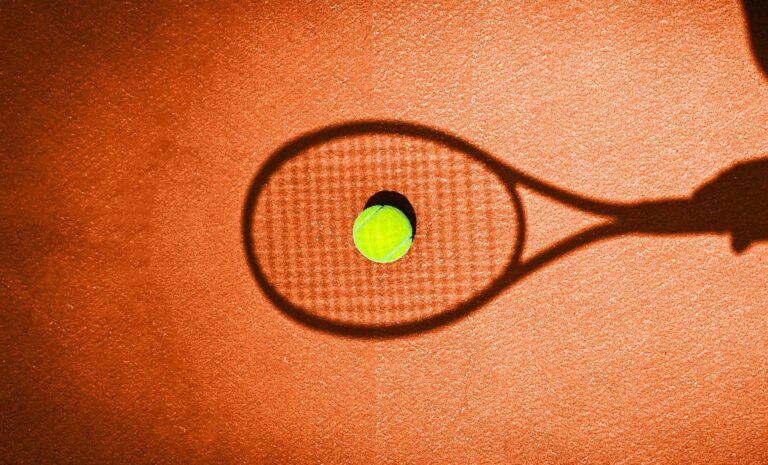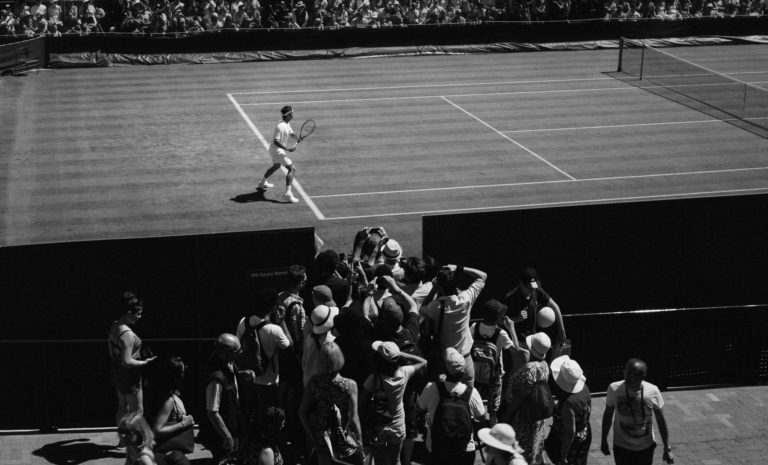When it comes to tennis terminology, there are words that every player and fan should know before stepping foot on the court. They may not directly help you win the match, but knowing and understanding this common tennis vocabulary will certainly make you feel more comfortable and prepared when stepping up to the line. For that reason, we’ve put together the ultimate tennis terminology list, packed full of all the tennis terms, words and slang you should know.
The Ultimate Tennis Terminology List
The list below includes petty much all of the tennis terminology and vocabulary you’ll hear in the tennis world, from watching tennis tournaments on tv to playing the game yourself. Rather than ordering the terms alphabetically, we’ve ordered them based on how they fit into the game.
The Basics
- Tennis Ball: that’s the fuzzy yellow thing you hit from one side of the court to the other. Not all tennis balls are the same, though you probably won’t notice much of a difference between them unless you’re playing an advanced level of tennis.
- Tennis Racket: that’s the thing you hit the ball with. Again, not all tennis rackets are the same. The best tennis racket for each player will depend on their age and technical ability. For example, children start with smaller rackets, and professional tennis players use heavier rackets that provide more power.
- Strings: the strings are what form the hitting surface on a tennis racket. Strings are classed as mains (vertical) and crosses (horizontal). Once again, not all strings are the same. Different string materials, patterns and tensions produce different spins on the ball, which can lead to different levels of control and power.
- Court: that’s the surface you play on. Please don’t call it a pitch. It’s a court!
- Grip: in tennis, a players grip refers to the way they hold the racket. Different grips lead to different techniques and ways of striking the ball. There are several types of tennis grip, though the most common are the continental grip, the eastern grip and the semi western grip.
- Singles Tennis: a tennis match involving two players, one on either side of the net.
- Doubles Tennis: a tennis match involving four players, two on each team. In doubles, the doubles alleys become part of the court.
- Point: a point is the smallest unit of scoring in tennis. Every point starts with a serve and ends when the ball either bounces twice or does not bounce inside the court on the correct side.
- Game: in tennis, a “game” is a collection of points during which one player serves. A game is won by winning at least four points, though may be more if a “deuce” score is reached.
- Set: A player wins a set when they win six games and are at least two games clear. If a 6-6 score is reached, the set is usually decided with a “Tie break”.
- Tie Break: a tie break is used to decide a set that reaches a 6-6 score. A tie break is one by the first player to reach 7 points being two points clear of their opponent. During a tie break, serve is changed after the first point and then every two points. If a 6-6 score is achieved, the tie break is played to 8, and so on.
- Championship Tie Break: an extended version of a regular tie break which is played to 10 points instead of 7. “Championship Tie Breaks” are often used in professional doubles tennis in place of a third deciding set. This is a common way of shortening matches and is becoming increasingly popular in club level tennis.
- Match: tennis matches are played to either the best of three or best of five sets (only at men’s Grand Slam events and Davis Cup ties).
- Straight Sets: a straight sets win is awarded to the player that wins a match without loosing a set. In best of three set matches, it will be a 2-0 win.
- Love: “love” is the term used to call a zero or “nil” score. It applies to points, games and sets, such as “15-love”, “six games to love” or “two sets to love”.
- All: “all” refers to an even score, meaning both players/teams have the same score.
- Deuce: a term used instead of “40-all” (40-40). Calling “Deuce” helps distinguish between “30-all” and “40-all” as the two can sound fairly similar.
- Advantage: The point following a “Deuce” score. If the player serving has advantage, they will call “advantage in”, if the receiver has the advantage they will call “advantage out”.
- Deciding Point: a deciding point is played when no-advantage scoring is used. In other words, one single point is used to decide a game instead of using advantage scoring. This scoring system is often used in professional doubles tennis and is becoming increasingly popular at a club level.
- Fault: a fault is a failed serve, which happens when the server misses the serve or commits a foot fault.
- Foot Fault: a foot fault occurs when a player steps on the line during the service motion. Foot faults aren’t very common in professional tennis, though are unfortunately seen a lot in club level tennis.
- Double Fault: when a server hits two faults in a row, which results in the point being lost.
- Let: a point that is replayed without a change to the score. A let usually occurs when a serve hits the net chord before bouncing into the correct service box. In club tennis, a let can often also be a replayed point due to a distraction interrupting the point, such as a ball rolling over from another court.
- Hold of Serve: in other words, it means to win a service game. In tennis, it’s often expected that the server will “hold their service games” as serving usually allows the player to take control of the point from the first shot.
- Break of Serve: when the returner wins the opponents service game, which is commonly called “breaking” the opponents serve.
- Break Point: a break point is a point at which the receiver has the chance to break their opponents serve.
- Bagel: a slang term to refer to a 6-0 score in a set.
- Bread Stick: a slang term used to refer to a 6-1 score in a set.

- Surface: that’s the type of tennis court you play on. There are a few different variations: hard courts, grass, clay, asphalt, AstroTurf/ artificial grass. Some that have fallen out of use include wood and carpet.
- Net: the net divides the two sides of the court. At its centre it is 3 feet (0.91 m) tall, and is 3 feet 6 inches (1.07 m) at the net posts.
- Forecourt: this is the front part of the court. It’s formed by the area between the service line and the net. Within it are the two service boxes.
- Service Line: is a line found 21 feet from the net and runs parallel to the net. It divides the forecourt and the backcourt and marks out the depth of the service boxes.
- Service Boxes: these are the two boxes found in the forecourt and are used as the target areas for the serve. There are two service boxes on either side of the net: one on the Deuce side and one on the Advantage side.
- Backcourt: the back area of the court, between the baseline and the service line.
- Baseline: this is the parallel line to the net that is furthest from the net. This is where players start a point by performing a serve.
- Centre Mark: a small mark at the centre of the baseline used to divide the back of the court into the Deuce court and the Ad court. It’s essentially a continuation of the line dividing the forecourt into the two service boxes.
- Deuce Court: this is the side of the court to which a player will serve when there is a deuce score. It is the right hand side of the court for each player.
- Ad Court: this is the side of the court to which a player will serve when there is an advantage score. It is the left hand side of the court for each player.
- Tramlines: these are the long 4 ft 6 ” boxes found at either side of the singles court. They are often referred to as the “doubles alleys” as they are only used in doubles tennis and are considered out in singles tennis.
- No Man’s Land: this is a slang term used to refer to the region of the court between the service line and the baseline. It is referred to as No Man’s Land because it is avoided if possible during a point as it is the most difficult part of the court to play from.
- Forehand: this is the shot you hit on your dominant side. So if you are right handed, your forehand will be hit on the right side of your body.
- Backhand: this is the shot you hit on the non-dominant side. If you are right handed, this will be on your left side. There are two variants of the backhand: the one-handed and the two-handed backhand.
- Serve: this is the shot used to start every point in a tennis match. It’s considered one of the most important shots in tennis, as well as one of the most difficult to master. Traditionally, a serve is performed overarm, though underarm serves are becoming increasingly popular.
- Ace: an ace is a direct serve in which the receiver is unable to touch the ball with their racket.
- Return: when a receiver returns the serve of the opponent.
- Approach: is the groundstroke hit by a player just before moving to the net for a volley.
- Volley: a volley is a shot often played from the net in which a player will hit the ball back without allowing it to bounce on their side of the court.
- Half-Volley: a specialty shot somewhere between a volley and a groundstroke. A half volley involves hitting the ball very shortly after the bounce.
- Topspin: is the forward rotation of a tennis ball caused by hitting low to high.
- Backspin / Slice: is the backward rotation of a tennis ball caused by hitting high to low.
- Dropshot: a specialty shot which involves hitting a very short ball using a slice spin that the opponent is unlikely to get back.
- Lob: a lob is a shot which involves hitting the ball over a player at the net, usually much higher than a normal groundstroke. The lob is a shot that is particularly effective against smaller players.
- Overhead/Smash: a shot hit above the head, with a technique very similar to the technique used in hitting a serve. An overhead or smash is often hit from the net and is usually a winning shot.
- Tweener: a specialty shot in which a player hits the tennis ball in between their legs.
Tactics & Strategy
- Rally: generally refers to a number of successive shots made by both players.
- Crosscourt: a cross court shot is played diagonally across the court. it’s often used during longer rallies in points.
- Down the line: a shot down the line is a shot played parallel to one of the sidelines. Shots down the line are often considered to be aggressive shots and are often more difficult to pull off.
- Inside-out forehand: when a player runs around their backhand to hit a forehand cross-court.
- Inside-in Forehand: when a player runs around their backhand to hit a forehand down the line.
- Neutralise the rally: when pushed deep and off the court into a defensive position, neutralising the rally is a way of restarting the rally and retaking control of the point. It often involves hitting a little higher than usual and keeping the ball deep where the opponent isn’t able to attack.
- Forced Error: when a player hits a shot so good that it forces the mistake from their opponent.
- Unforced Error: when a player makes an unnecessary mistake.
- Passing Shot: this is a shot used to pass a player that is at the net. Most often they are regular forehands or backhands, though a lob can also be considered a passing shot.
- Serve & Volley: a tennis tactic which involves serving and racing to the net as quickly as possible for a volley. The serve and volley tactic can be very effective in shortening points and winning them before giving the opponent the chance to enter the rally. It’s a popular tactic used on grass courts.
- Chip & Charge: a tactic used by players that prefer being at the net than at the baseline. It involves hitting a deep slice shot and forcing your way into the net, forcing the opponent to hit a passing shot.
- Counterpuncher: a player that likes to stay behind the baseline and play defensive tennis, allowing the opponent the take control of the point.
- Moonball: a slang term used for a high and deep shot that is intended to disrupt the opponents rhythm during a point and push them back in the court.
- Poach: poaching is a tactic used in doubles tennis that involves the net player crossing over at the net to “poach” the ball and hit a shot that was intended for their partner.
Tournaments & Professional Events
- ATP: the Association of Tennis Players is the governing body for the men’s tennis tour.
- ITF: the International Tennis Federation is the international governing body for competitive tennis and is in charge of overseeing ITF Futures and Challenger events.
- WTA: the Women’s Tennis Association is the governing body for the women’s tennis tour.
- Grand Slam: the name given to the four most prestigious tournaments in the world: the Australian Open (hard courts), the French Open / Roland Garros (clay), the Wimbledon Championships (grass) and the US Open (hard courts).
- Masters Event: also referred to as Masters 1000 events, they are the second most prestigious form of tournament on the professional tennis tour.
- Seeded Player: this is a ranked player at an event. Being a seeded player usually gives the advantage of a favourable draw in the earlier rounds of a tournament. The number of seeded players at an event depends on the size of the draw.
- Qualifier: a player that has made it into the main draw of an event by playing qualifying rounds.
- Wildcard: when a player is awarded a “wildcard”, they are given immediate entry into the main draw of a tournament without having to compete in the qualifying rounds. Wildcards are awarded to players that show great potential though due to their ranking would have to make their way through qualifying.
- Lucky Looser: a “Lucky looser” is a player that lost in the last round of qualifying at an event but is awarded a spot in the main draw when another player withdraws from the event at short notice.
- Walk-over: a walk-over is awarded to a player whose opponent has withdrawn or is unable to play.
- Warning: a warning can be given to a player by the umpire for a variety of reasons, the most common being a time violation, a racket abuse (breaking a racket) warning or an unsportsmanlike misconduct (use of abusive language).
- Time Violation: a voilation resuting in a warning due to a player taking longer than the permitted time between points, which is traditionally 20-25 seconds depending on the event.
- Protected Ranking: when a player is making a return from injury, they have access to a protected ranking which allows them to use and average ranking achieved before their injury occurred. This can be extremely helpful when a player spends a significant amount of time away from the tour and drops in the rankings. A protected ranking allows them to get into main draws where their current ranking would not allow it.




